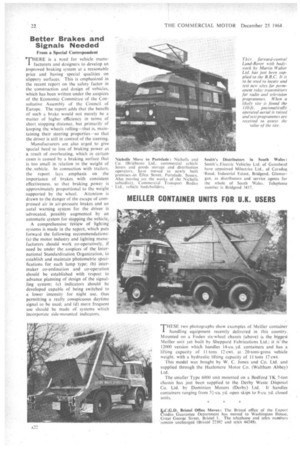Better Brakes and Signals Needed
Page 24

If you've noticed an error in this article please click here to report it so we can fix it.
From a Special Correspondent
THERE is a need for vehicle menufactor-era and designers to develop an improved braking system at a reasonable price and having special qualities on slippery surfaces. This is emphasized in the recent report on the safety factor in the construction and design of vehicles, which has been written under the auspices of the Economic Committee of the Consultative Assembly of the Council of Europe. The report adds that the benefit of such a brake would not merely be a matter of higher efficiency in terms of short stopping distance, but primarily of keeping the wheels rolling—that is, maintaining their steering properties—so that the driver is still in control of the steering.
Manufacturers are also urged, to give special heed to loss of braking power as a result of overheating, which in certain cases is caused by a braking surface that is too small in relation to the weight of the, vehicle. In connection with trailers, the report lays emphasis on the importance of brakes with consistent effectiveness, so that braking power is approximately proportional to the weight supported by the wheel. Attention is drawn to the danger of the escape of compressed air in air-pressure brakes and an aural warning system for the driver is advocated, possibly augmented by an automatic system for stopping the vehicle.
A comprehensivereview of lighting systems is made in the report, which puts forward the following recommendations: (a) the motor industry and lighting manufacturers should work co-operatively, if need be under the auspices of the International Standardization Organization, Co establish and maintain photometric specifications for each lamp type; (b) intermaker co-ordination and co-operation should be established with respect to advance planning of design of the signalling system; (c) indicators should be developed capable of being switched to a lower intensity for night use, thus permitting a really conspicuous daytime signal to be used; and (d) more frequent use should be made of systems which incorporate side-mounted indicators.








































































